Last Updated on April 17, 2025 by Owen McGab Enaohwo
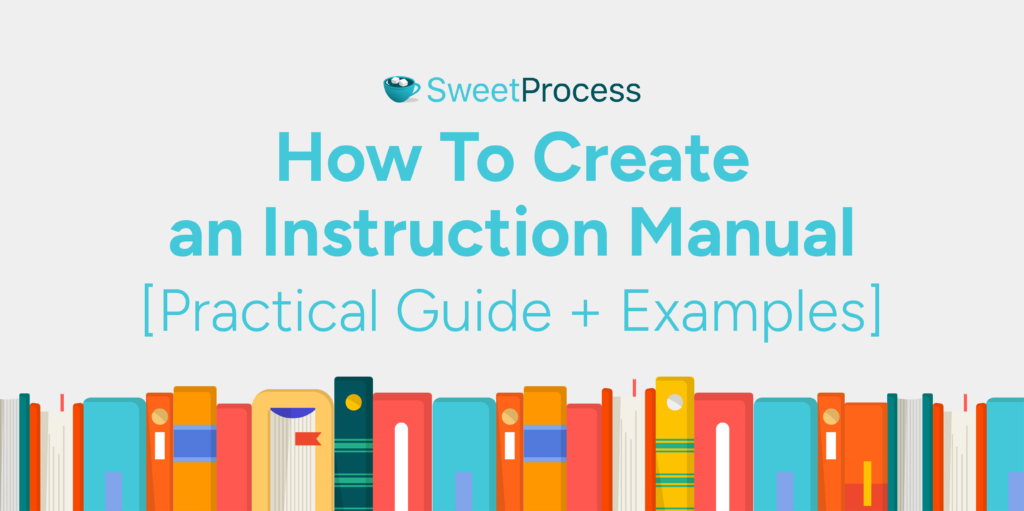
Imagine buying a new gadget and not knowing how to use it. You want to make soup using a new immersion blender, but you don’t even know how to turn the device on.
That’s where an instruction manual comes in handy. It’s a guide that helps you understand and use a product correctly, improves user experience, and reduces confusion.
Creating effective user instruction manuals doesn’t have to be hard. With the right steps and tools, you can make manuals that are easy to follow. This guide will walk you through the step-by-step process of crafting instruction manuals simple to understand and truly helpful.
SweetProcess is a tool for creating and managing instruction manuals. It offers a user-friendly interface and efficient features to help you streamline your documentation process. Start a free trial today with no credit card required.
TABLE OF CONTENTS
What Is an Instruction Manual?
How To Write an Effective Instruction Manual (in 9 Steps)
How To Create and Manage Your Instruction Manuals With SweetProcess
Why Are Instruction Manuals Important?
What Are the Elements of an Effective Instruction Manual?
Best Practices for Crafting Instruction Manuals
Instructional Manual Examples to Inspire Your Team
What Is an Instruction Manual?
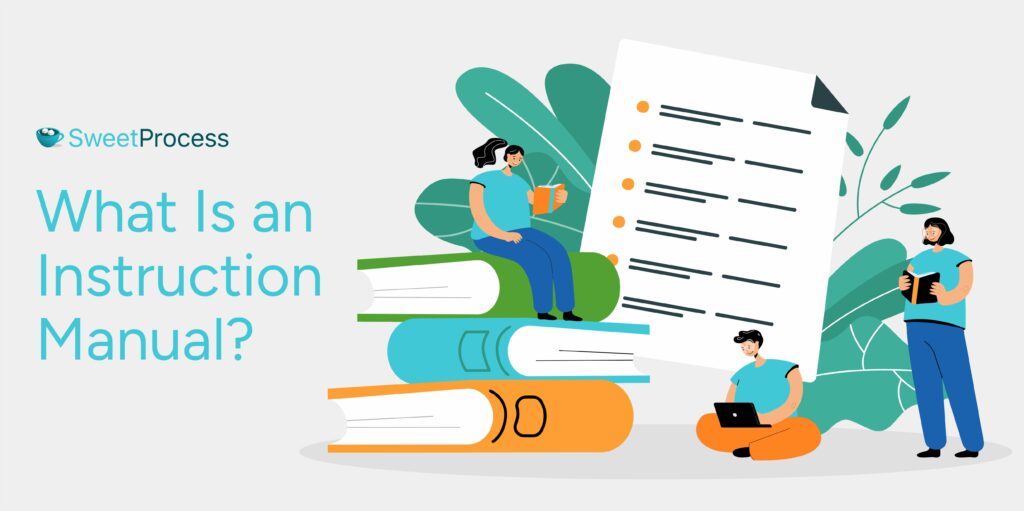
An instruction manual, also known as a user guide, is a document that provides detailed information on how to use, operate, or maintain a product or system. It helps users understand the functionalities and features of a product, ensuring they can use it effectively and safely.
In a company setting, instruction manuals are typically used to provide employees or customers with clear directions on various processes, products, or services.
How To Write an Effective Instruction Manual (in 9 Steps)
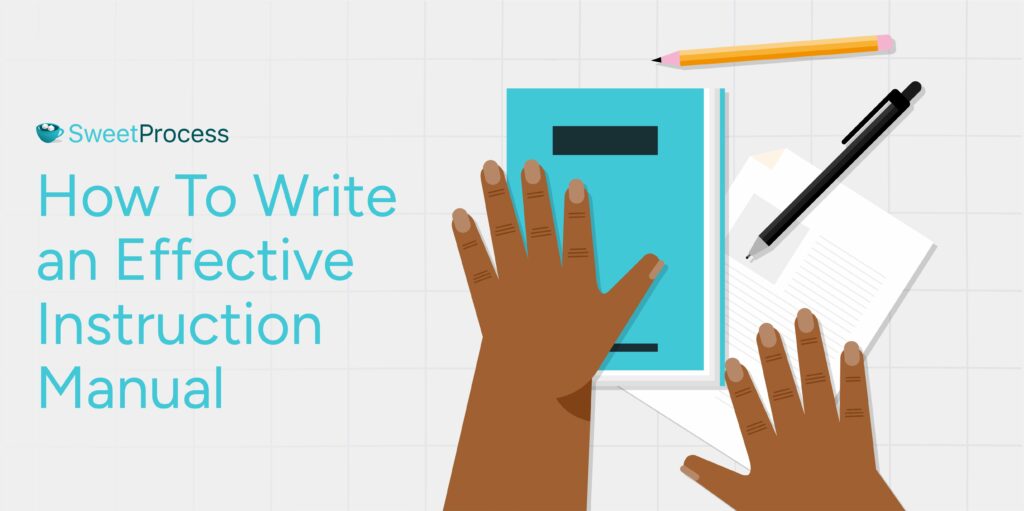
Writing a detailed instructions manual doesn’t have to be a headache. Whether you’re creating a guide for a software tool, a physical product, or an internal process, a well-structured manual makes life easier for users. Let’s break it down into nine simple steps.
1. Define the Purpose and Scope
Before you start, ask yourself: What is this manual for, and who will use it? A good manual focuses on solving a problem or guiding users through a process.
For example, if you’re writing a manual for a project management tool, your goal might be to help new users successfully set up their first project. Keep your scope clear; don’t cram everything into one document. Instead, consider separate guides for beginners, advanced users, and troubleshooting.
2. Determine the Information Users Need

Think from the user’s perspective. What questions will they have? What could confuse them?
For example, if you’re writing a guide for a coffee machine, users will likely need steps on setting it up, brewing coffee, cleaning, and troubleshooting. If it’s for a SaaS tool, they might need help with onboarding, integrations, and common issues.
One way to gather this information is to talk to customer support teams; they know what users struggle with the most.
3. Collect Detailed Product Information
You can’t explain something well if you don’t fully understand it. Gather detailed information from:
- Product designers or engineers
- Customer support teams
- FAQs and existing documentation
If possible, use the product yourself. Hands-on experience helps you write clearer, more clear instructions.
For example, Josiah Lipsmeyer, Founder and CEO of Plasthetix, understands the power of detailed user documentation and has this to say about creating instruction manuals for his company:
“Because our detailed guides cover everything from keywords to content, our surgeons see impressive growth and increased patient interaction.”
Whether in marketing, healthcare, or any other industry, the right manual provides users with the insights they need to succeed.
4. Draft the Instruction Manual Outline
An outline keeps your manual structured and easy to follow. A basic outline might look like this:
- Introduction (What the product/process is and who it’s for)
- Setup or installation steps
- How to use the product or process
- Maintenance and troubleshooting
- FAQs and additional support
Think of it like a roadmap. It guides both you and the reader.
5. Start Writing the Manual

Now, it’s time to write! Keep your language simple and direct.
Don’t say: “Utilize the aforementioned steps to ascertain successful implementation.”
Do say: “Follow these steps to set it up correctly.”
Break important information into small chunks and use bullet points where possible. If a step has multiple actions, number them.
Example:
To reset your account settings, follow these steps:
- Press and hold the reset button in the dashboard for 10 seconds.
- Wait for the confirmation message to appear on your screen.
- Enter the default passcode when asked to restore your settings and set them up again.
If you need help, check out our Help Center or contact our support team.
6. Add Visuals for Clarity
People process visuals faster than text, so include the following:
- Screenshots (for software manuals)
- Diagrams (for physical products)
- Videos or GIFs (for complex steps)
For example, IKEA’s furniture manuals rely mostly on images, making them easy to follow regardless of language. If your product is digital, highlight buttons and menus in screenshots to help users navigate.
7. Test the Manual’s Effectiveness
Before publishing, test your manual with real users. Ask:
- Do they understand the steps?
- Are any parts confusing?
- Are they able to complete the task without extra help?
Lara Woodham, Owner of Rowlen Boiler Services, stresses the importance of clarity in user instruction manuals.
“When we create these manuals, it’s not just about providing instructions; it’s about ensuring safety and efficiency, helping our clients understand the benefits of maintaining their systems properly.”
Get feedback from a mix of beginners and experienced users. Adjust the content based on their responses.
8. Finalize and Polish the Manual
Now, refine your manual:
✔ Check for typos and unclear instructions
✔ Ensure formatting is consistent (headings, fonts, colors)
✔ Add a table of contents for easy navigation
If you have digital instruction manuals, include hyperlinks to quickly access different sections.
9. Keep the Manual Updated
A great manual evolves with your product. If new features are added, update the guide.
Maurizio Petrone, Founder & CEO of PressHERO, points out a key benefit of keeping user documentation updated:
“The manual serves as our single source of truth. When we update our processes or implement new tools, having a centralized document ensures everyone stays aligned with our latest procedures.”
For example, if your SaaS tool introduces a new dashboard layout, update the screenshots and instructions. Set a schedule to review your manuals regularly so they stay accurate and helpful.
How To Create and Manage Your Instruction Manuals With SweetProcess

Creating and managing instruction manuals is essential for any business that wants consistency, efficiency, and clear communication across teams. However, doing it manually can be frustrating and time-consuming. That’s where SweetProcess comes in.
With SweetProcess, you can easily document, organize, and share instruction manuals as step-by-step guides. Also, you can manage company policies and even turn your manuals into a knowledge base for external users. Here’s how SweetProcess helps you streamline these processes.
Document Your Instruction Manual as Step-by-Step Guides
The best way to ensure that employees follow procedures correctly is to document them in a structured, easy-to-follow format. With SweetProcess, you can create step-by-step guides for your instruction manuals, complete with images, videos, and attachments to make instructions clearer.
This approach proved invaluable for MonteVista Homes, a second-generation family-owned home-building company in Oregon, which struggled with disorganized standard operating procedures (SOPs). Initially, they documented their processes on loose-leaf papers and desk manuals, but they quickly realized that these documents were hard to maintain and update.
SweetProcess provided them with an easy-to-use system where they could create step-by-step guides for their construction projects. This streamlined their workflow and allowed trade partners to follow a standardized process, eliminating knowledge gaps and inefficiencies. As a result, MonteVista Homes significantly improved the efficiency of their home-building process, ensuring consistency across multiple job sites.
Here’s how to document a procedure with SweetProcess:
Step 1: Create an account or log in and complete setup steps, including adding your team.
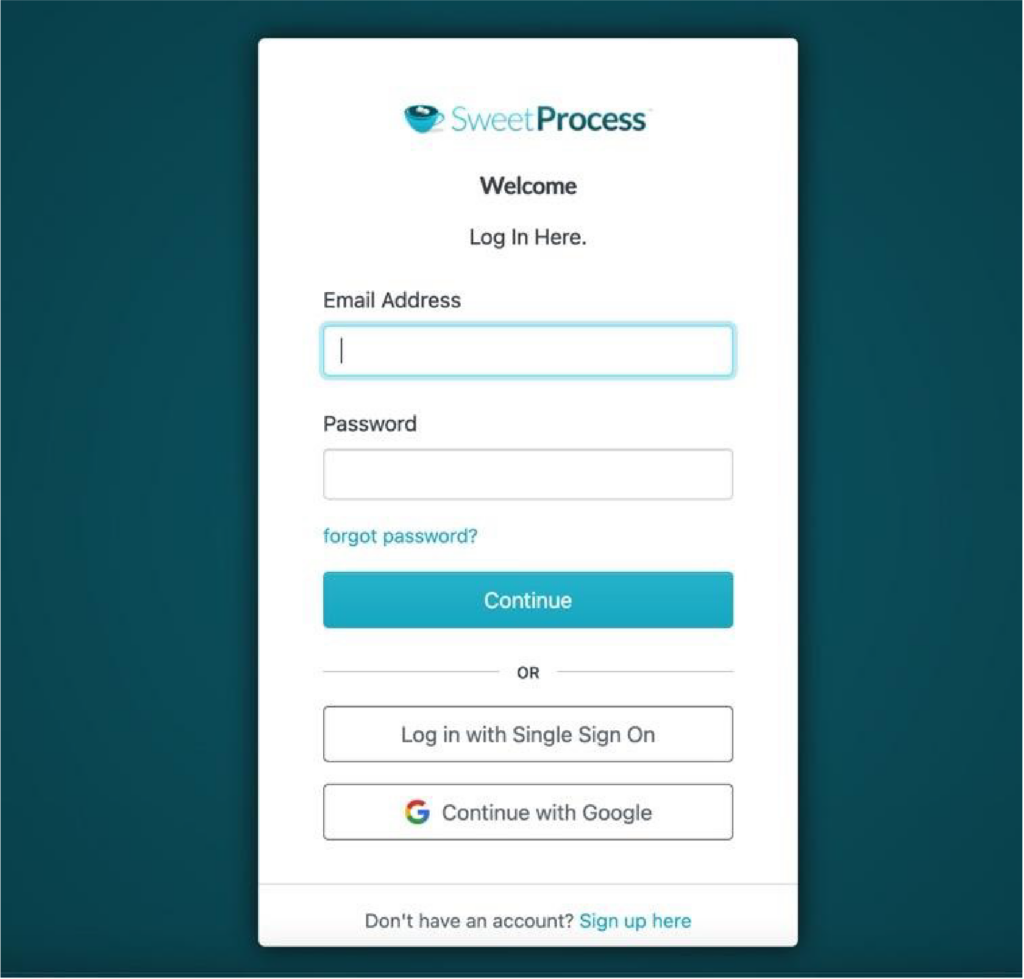
You have the opportunity to import your already existing procedures, but if you wish to create them from scratch, you can always skip these steps and continue with them later.
Step 2: Click “More” and select “Procedures.”

Step 3: Enter a name and assign it to a team. Click “Continue.”

Step 4: Click the procedure title and provide a description.

Step 5: Organize your procedure with relevant tags.
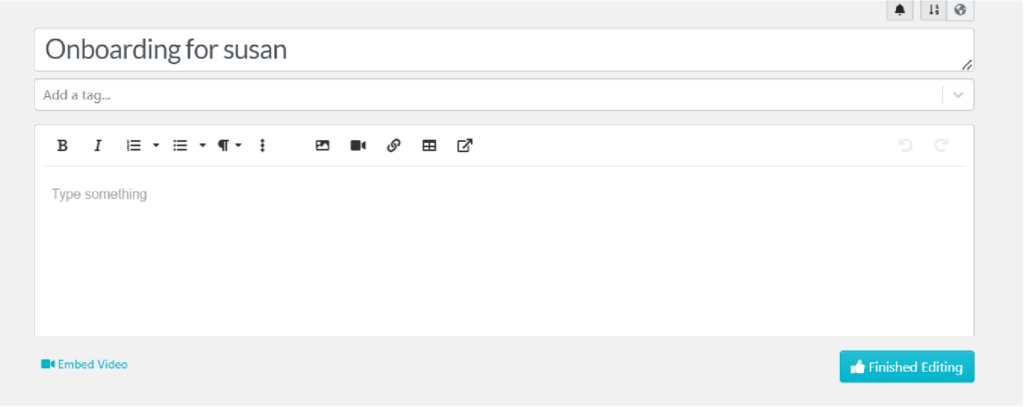
Step 6: Click “Add a Step,” provide a title and description, and include media if needed.
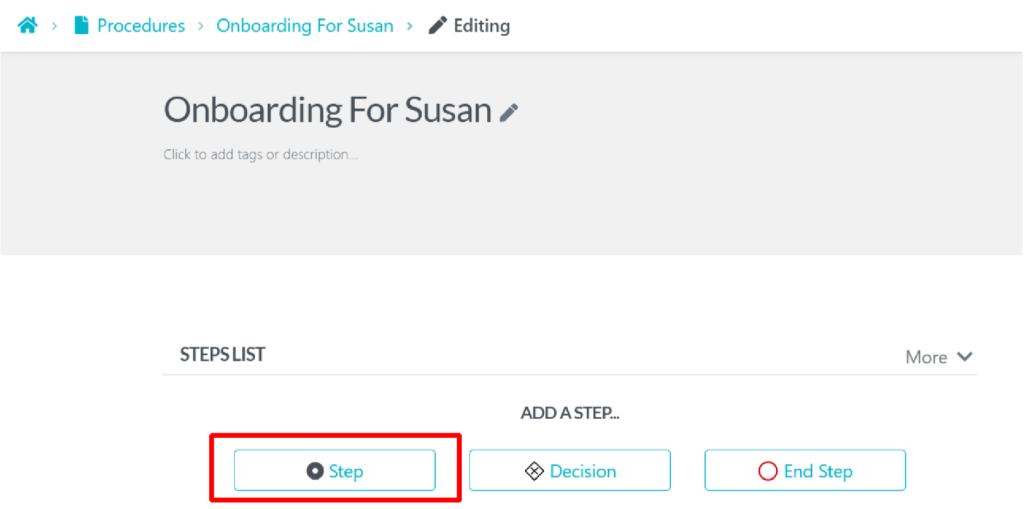
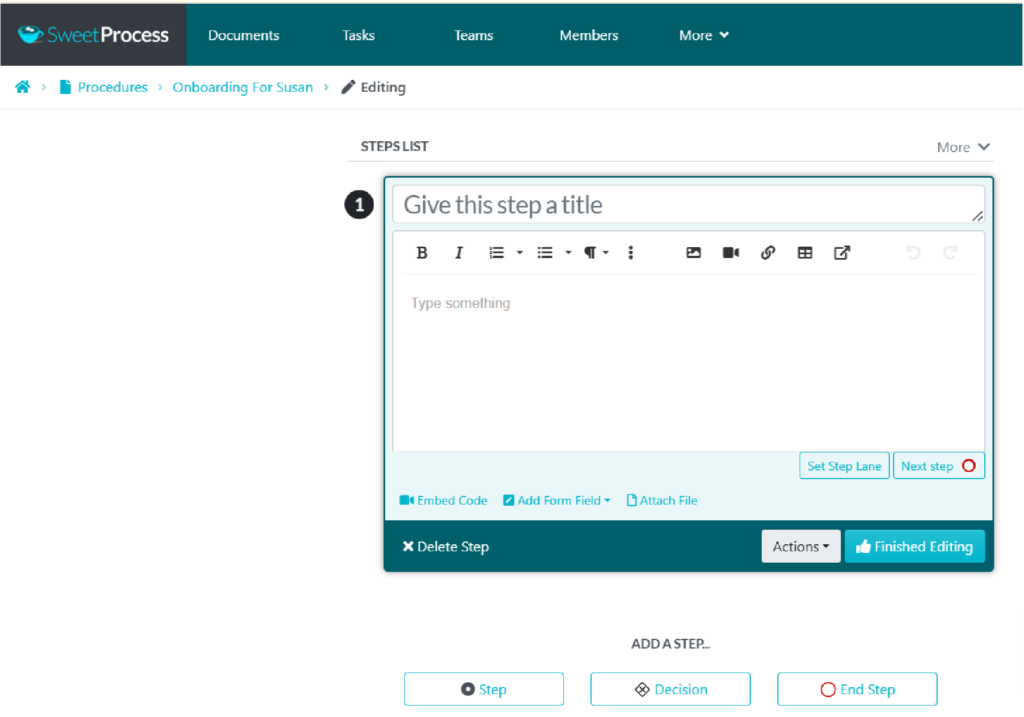
Step 7: Click “Approve” to finalize the procedure.

After all is done, click “Procedures” to return to the dashboard, where you can view and manage all your procedures.
Create Company Policies on How To Use Your Instruction Manuals
Instruction manuals are only useful if employees know how to use them. That’s why it’s important to have company policies in place outlining when and how manuals should be referenced.
With SweetProcess, you can create company policies that clearly define:
- Who should use the instruction manuals (e.g., new hires, managers, specific teams).
- When and how they should be used (e.g., during onboarding, when troubleshooting issues, or for compliance requirements).
- How employees can provide feedback on manuals to ensure continuous improvement.
This process helped Forensic Analytical Consulting Services (FACS), which faced challenges in maintaining consistency across multiple locations. Their existing SOPs were stored in PDF files on company servers, which employees rarely accessed. Instead of consulting the SOPs, employees relied on managers like Kevin Trapp, director of operations, for guidance, creating inefficiencies.
After implementing SweetProcess, FACS developed clear policies on how and when employees should use instruction manuals. By making manuals easily accessible and searchable, the company eliminated dependency on individual managers. Employees now follow structured guidelines, reducing confusion and improving efficiency across the company.
Here’s how to use SweetProcess to manage and create your company’s policies:
Step 1: On your SweetProcess account home page, go to the “Policies” tab.
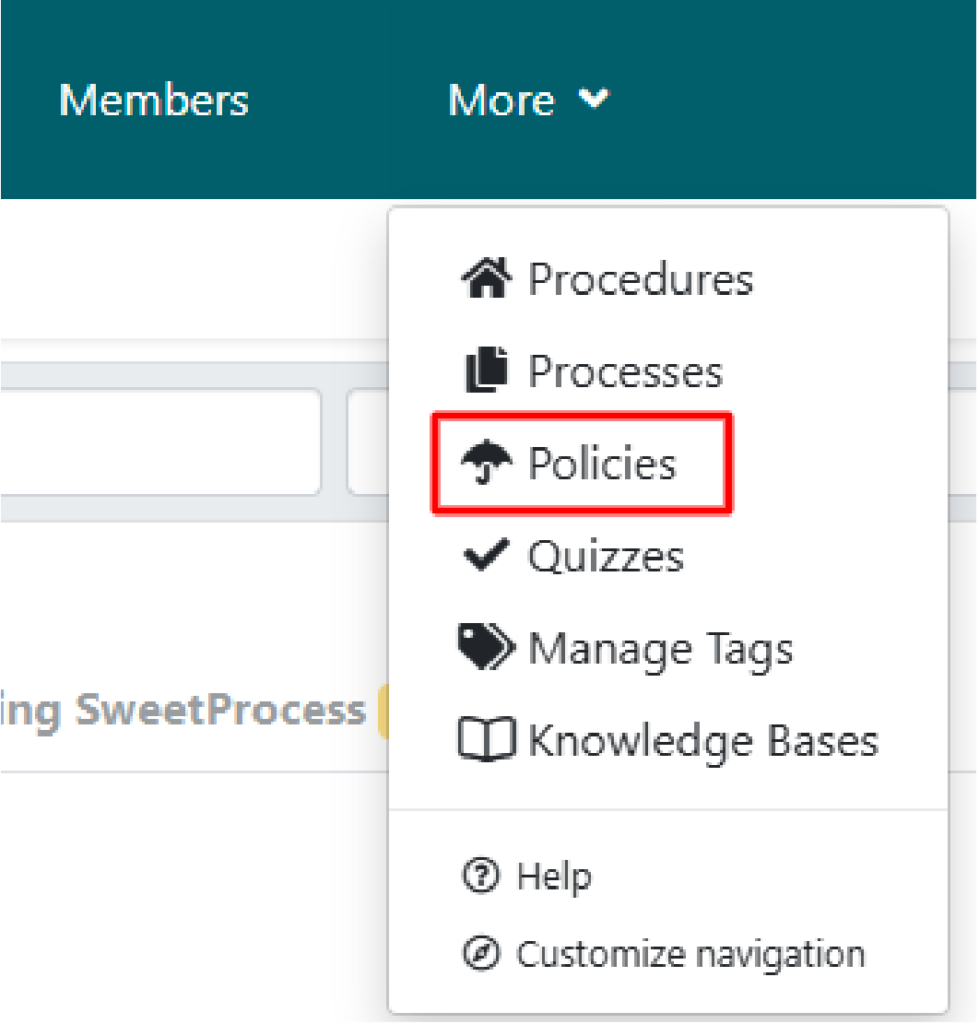
Step 2: Click “Create Policy,” add a title, assign it to a team, and click “Continue.”


Step 3: Provide a title and description.
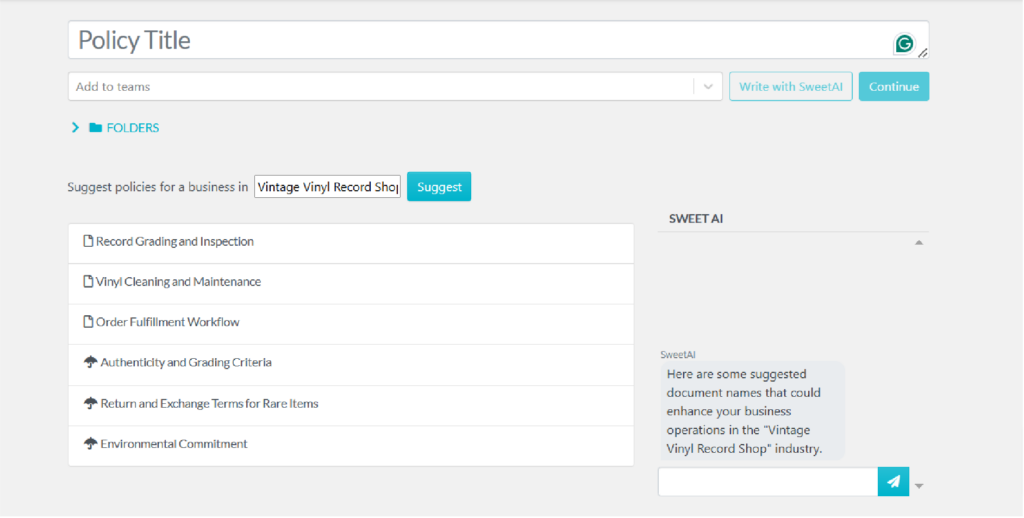
Our SweetAI feature can help you write your company’s policy from scratch if you don’t have an existing one. Simply suggest a policy title for your business, and let the AI guide you through the process.
Step 4: Review the policy and click “Approve” to make it live.

Bring clarity to your organization by documenting your policies with SweetProcess. Start your free trial now.
Turn Your Instruction Manuals into an External Knowledge Base
Spark Marketer, a digital marketing agency, initially stored their SOPs in Google Docs, making it difficult for employees to find the right information. As the company grew, it needed a better way to share standardized procedures with employees and clients alike.
SweetProcess enabled Spark Marketer to build a centralized external knowledge base where employees and clients could quickly access relevant information. The ability to categorize and structure procedures meant that employees no longer wasted time searching for information. Additionally, clients could refer to well-documented guides, reducing the number of support requests and making processes more transparent.
How To Build a Knowledge Base with SweetProcess
Step 1: Click “More” on the dashboard and select “Knowledge Bases.”

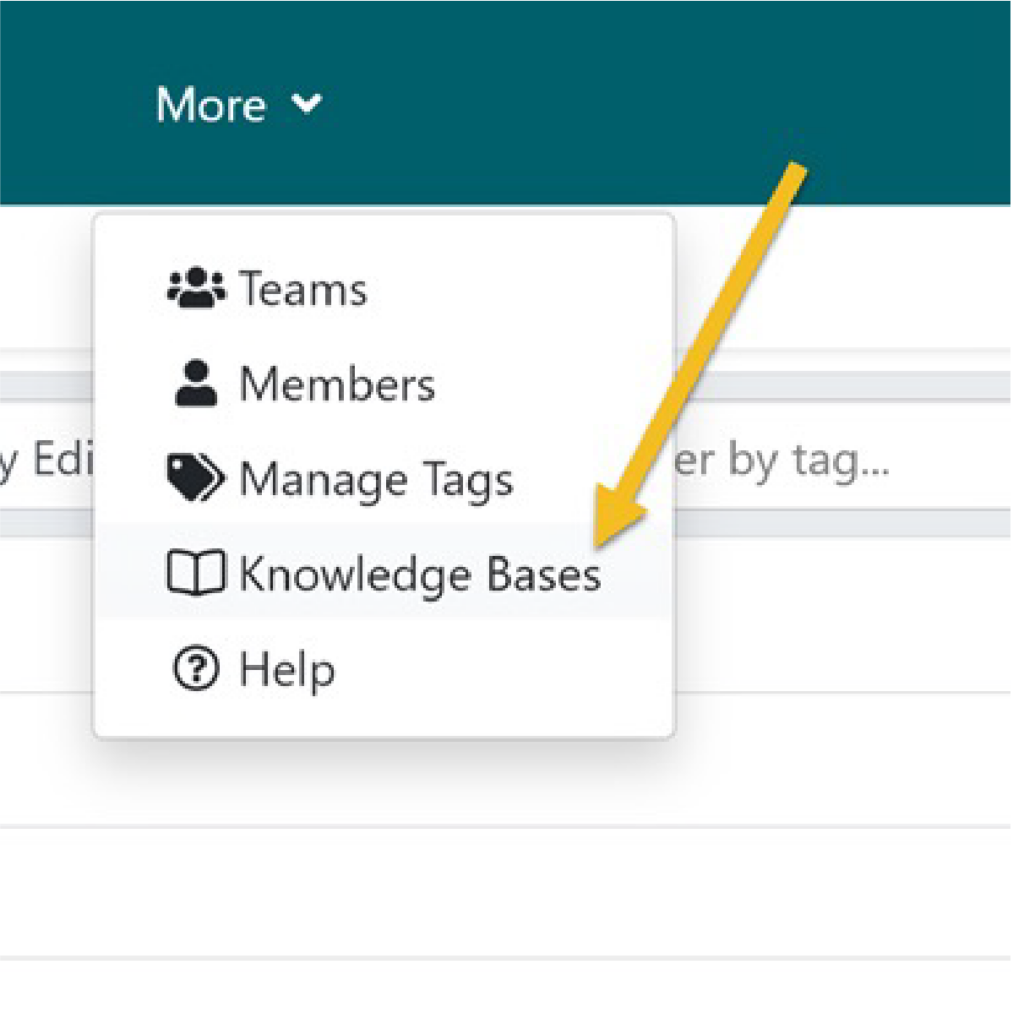
Step 2: Click “Create Knowledge Base.”

Step 3: Enter a title and click “Continue.”

Manage Your Company’s Instruction Manuals and Policies in One Place
One of the biggest benefits of using SweetProcess is that it serves as a centralized hub for all your instruction manuals and policies. Instead of storing documents across different platforms, you can keep everything in one place, making updates easy and ensuring all employees are on the same page.

This feature helped Rise25, a company specializing in podcast marketing, which initially struggled with scattered and unstructured SOPs in Google Docs. Employees had difficulty finding the right procedures, and team members constantly had to ask for guidance.
By moving to SweetProcess, Rise25 was able to centralize all its instruction manuals and policies in one place, ensuring that employees could quickly locate the information they needed. The built-in search function, document linking, and approval workflows made it easier for the team to stay organized and efficient. As a result, Rise25 significantly reduced operational bottlenecks and streamlined its content creation process.
Managing instruction manuals doesn’t have to be difficult. With SweetProcess, you can create, organize, and share step-by-step guides, policies, and knowledge bases all in one platform.
Why Are Instruction Manuals Important?

Instruction manuals might not be the first thing people think about when they buy a product, but they play a huge role in customer satisfaction and business success. A well-crafted manual ensures that users can understand and use a product properly, which leads to fewer frustrations and better overall experiences.
Businesses prioritizing clear and structured instruction manuals see better customer retention, fewer support requests, and even higher sales. Below are some reasons why instruction manuals are so important and how they impact both businesses and customers.
Reduces the Workload of Support Teams
One of the biggest challenges businesses face is handling overwhelming customer support requests. If customers or employees don’t know how to use a product or follow an internal process, they contact support for answers.
A well-structured instruction manual acts as a self-service knowledge base, allowing customers and employees to find solutions on their own. This reduces the burden on support teams, enabling them to focus on high-value tasks rather than repeatedly answering the same questions.
For example, Jeremy Weisz, co-founder of Rise25, shared how moving their scattered documentation into a centralized knowledge base using SweetProcess drastically reduced internal questions and improved operational efficiency. Employees could find answers themselves, cutting down on interruptions and freeing up time for strategic work.
High Customer Retention
Customer experience plays a massive role in business growth. Customers who struggle to understand how to use a product or service become frustrated and are more likely to churn. A clear instruction manual removes confusion, ensuring customers get value from their purchase.
Satisfied customers are more likely to stick around, renew subscriptions, and even refer others to your business. Having structured, easy-to-access documentation improves retention and reduces refund requests.
Higher Conversion Rates
Trust is key when businesses decide to purchase a product or service. If potential customers see that your business provides comprehensive documentation, they’ll have more confidence in your offering.
Clear and accessible instruction manuals help businesses reduce friction in the buying process. When prospects know they won’t struggle to understand your product, they’re more likely to convert into paying customers.
Saves Time and Resources
Time is one of the most valuable assets in business. Without proper documentation, employees waste hours searching for information, asking repetitive questions, or fixing preventable mistakes. Every minute spent on unnecessary support inquiries or operational inefficiencies is money lost.
A well-maintained instruction manual streamlines training, improves the employee onboarding process and ensures consistency across teams. This results in faster decision-making and improved productivity.
Prevents Product Misuse
Misusing a product or service can lead to frustration, support issues, and even legal liabilities for businesses. Customers and employees need clear guidance to use a product safely and effectively. An instruction manual prevents costly mistakes, warranty claims, and potential reputational damage.
A well-documented user guide prevents customers from misconfiguring software, losing data, or failing to implement features properly. In industries like construction or healthcare, improper usage can be dangerous.
Try SweetProcess for free and see how easy it is to create structured, easy-to-update instruction manuals that support your team and customers. Start your free trial today!
What Are the Elements of an Effective Instruction Manual?

Creating an instruction manual is more than just writing down steps. A well-structured manual helps users understand and use a product correctly without frustration. Whether it’s a software application, a kitchen appliance, or industrial machinery, an effective manual should be clear, concise, and easy to navigate. Below are the key elements that make an instruction manual truly useful.
Introduction
Every great instruction manual starts with an introduction. This section provides a brief overview of the product or services and explains what the manual covers. It should answer questions like:
- Who should use this manual? (Warehouse staff, drivers, or administrative personnel)
- What will they learn? (How to properly label, track, and deliver packages)
- Why is it important? (To reduce lost shipments and improve delivery efficiency)
Setting clear expectations helps employees and customers understand why they should follow the manual.
Safety Information

Safety always comes first. This section highlights any risks associated with using the product and how to avoid them. For example, a manufacturing company producing heavy equipment needs clear safety guidelines to prevent workplace injuries. The manual should include:
- Personal protective equipment (PPE) requirements for handling machinery
- Emergency shut-off procedures for malfunctioning equipment
- First-aid steps in case of minor injuries
- Getting Started
The “Getting Started” section is crucial for businesses training new employees or onboarding customers. This part should provide a step-by-step guide on setting up and using a system, product, or process.
An example of this is a project management software company. It needs a clear onboarding guide for new users, which should include:
- How to create an account
- Setting up the first project
- Inviting team members and assigning roles
- Navigating the dashboard and key features
For a retail business, this section should outline how to set up the point-of-sale (POS) system, process transactions, and manage inventory.
Operation Instructions
This is the heart of your manual. It explains how to use the product or service step by step. Be clear and direct, using numbered steps and bullet points where needed.
For example, a task management system manual might include:
- Log in to your account using your email and password.
- Create a new task by clicking the “Add Task” button.
- Assign the task to a team member and set a due date.
- Choose a priority level to help organize workflow automation.
- Click “Save” to finalize the task and track progress.
Using simple language and visuals ensures that even first-time users can follow along without confusion.
Maintenance and Care
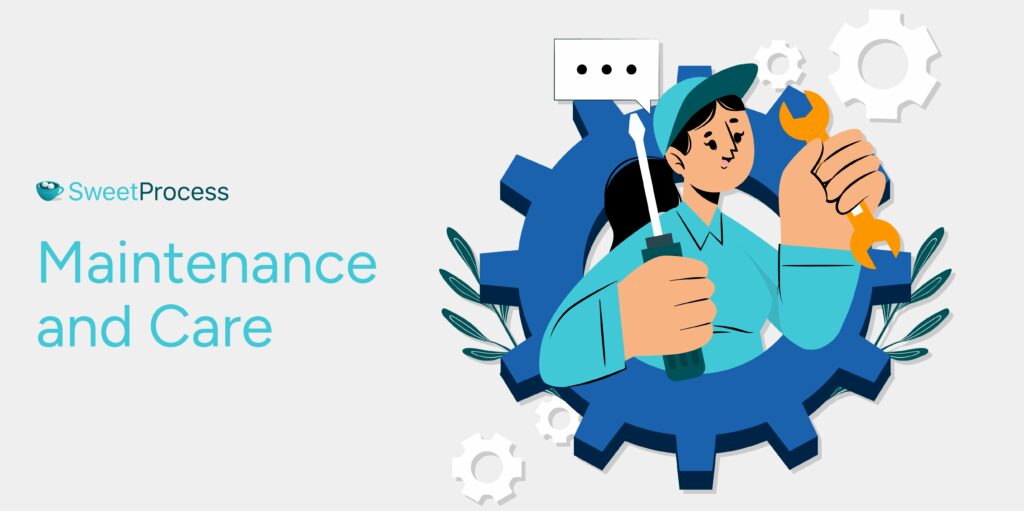
Every business relies on tools, software, and equipment that require regular maintenance. A clear maintenance guide reduces downtime, extends equipment lifespan, and prevents costly repairs. For an office-based business, this could mean guidelines for maintaining IT equipment like servers, printers, and software updates to prevent disruptions.
Keeping everything in working order ensures business continuity and cost savings over time.
Troubleshooting
No matter how well a system is designed, issues will arise. The troubleshooting section helps employees and customers quickly resolve common problems without needing to contact support.
For example, an e-commerce business should include troubleshooting steps in their online order processing manual, such as:
- Issue: A customer didn’t receive an order confirmation email
Solution: Check spam folders and verify the email address - Issue: The payment gateway is declining transactions
Solution: Ensure the payment processor is online and check for flagged transactions
Providing quick fixes saves users from unnecessary frustration and reduces the need for customer support calls.
Technical Specifications
For businesses dealing with equipment, software, or specialized tools, technical specifications are essential. This section provides precise details that help employees or customers make informed decisions.
For example, a B2B software company selling a customer relationship management (CRM) system technical specifications could include:
- System requirements (e.g., compatible browsers, operating systems)
- Integration options with third-party applications
- Data storage limits and security compliance details
- Warranty and Support
Users need to know what kind of support is available if something goes wrong. This section should clearly outline the product’s warranty, including:
- What is covered under the warranty.
- How long the warranty lasts.
- How to claim a repair or replacement.
- Contact details for customer support.
If you’re looking for an easy way to create professional instruction manuals with step-by-step guides, visuals, and built-in updates, SweetProcess makes it simple.
Best Practices for Crafting Instruction Manuals
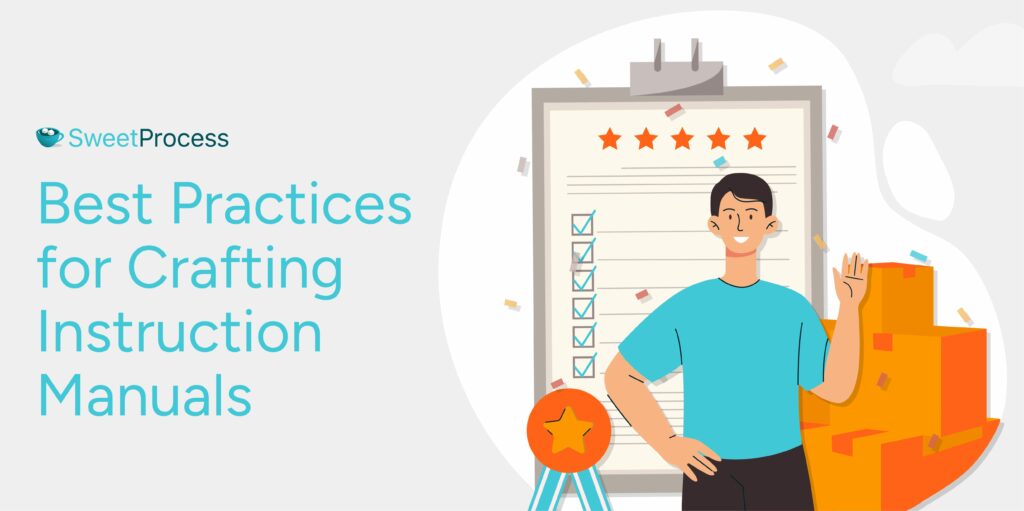
A well-crafted instruction manual helps businesses run smoothly by ensuring employees and customers can follow processes without confusion. Whether you’re managing a team, training new hires, or helping customers use your product, a clear manual saves time and reduces errors.
Here are the best practices for creating an effective instruction manual that’s easy to understand and follow.
Use Clear and Direct Language
The best instruction manuals are easy to read. Avoid technical jargon unless absolutely necessary. If you must use them, provide a simple explanation. Use short sentences and straightforward wording so that anyone can follow along.
For a software company, instead of saying, “Initialize the user authentication protocol,” say, “Log in with your username and password.”
The simpler the instructions, the faster employees and customers can get things done.
Provide Detailed Explanations
While instructions should be simple, they must also be complete. Skipping important details can lead to mistakes. Make sure each step has enough information for users to follow without guessing. Providing enough detail ensures employees complete tasks correctly and safely.
Incorporate Visual Aids
People process images faster than text. Adding diagrams, screenshots, or videos makes it easier to understand complex instructions. Visual aids are especially useful for hands-on tasks like assembling products, operating machines, or using software.
For a SaaS business, use screenshots to show:
- Where to click
- How to fill out forms
- What the user interface should look like at each step
For more information on creating step-by-step guides with visuals, see our work instruction templates.
Ensure Accuracy and Consistency
Inaccurate or conflicting instructions can lead to costly mistakes. Your manual should be fact-checked and tested before being distributed. Consistency in tone, formatting, and terminology also helps create a smooth reading experience. Testing and refining your manuals reduces mistakes and improves user trust.
Maintain a Uniform Style and Format
Your instruction manual should look clean and professional. A disorganized manual with inconsistent fonts, random formatting, or different writing styles can confuse users.
For software guides, using the same button names, commands, and terminology ensures that users won’t get lost.
Leverage Pre-Designed Templates
Creating instruction manuals from scratch can be time-consuming. Using pre-designed instruction manual templates saves time and ensures consistency. Templates provide a structured layout that makes your manuals easier to read and use. Using templates also speeds up documentation and ensures every manual follows the same high-quality structure.
For ready-to-use templates, check out our operations manual templates.
Highlight Safety Tips and Precautions
If your instructions involve any risks, hazards, or safety measures, make sure they are clearly marked. Use bold text, warning symbols, or callout boxes to emphasize them.
For example, a manufacturing plant creating an equipment manual should include:
Highlighting safety precautions reduces workplace accidents, compliance issues, and financial risks.
Streamline the Process With Automation
Manually updating instruction manuals is time-consuming. Automation tools like SweetProcess help businesses create, update, and distribute manuals with ease. Instead of juggling multiple documents, teams can collaborate in real-time, update instructions instantly, and ensure employees always have the latest version.
Ready to streamline your instruction manuals and make documentation easier? Sign up for a free trial of SweetProcess today!
Instructional Manual Examples to Inspire Your Team

Creating an effective instruction manual is essential for guiding users through the proper use of a product or service. Here are four exemplary instruction manuals that stand out for their clarity, organization, and user-friendliness:
- Apple Support User Guides
Apple provides comprehensive online user guides for its products, such as iPhones, Macs, and AirPods. These guides are categorized by device and feature, allowing users to quickly find the information they need. The inclusion of a search function and language preferences enhances accessibility and user experience. - Slack Help Center
Slack’s user guide offers an intuitive browsing experience with feature suggestions based on user search intent, resulting in a personalized customer experience. The guide also includes a feedback section at the bottom of each page, allowing users to indicate whether the information was helpful, which aids Slack in understanding user sentiment and improving communication gaps. - SharkNinja User Manual
SharkNinja’s user manuals for the Ninja Foodi air fryer not only provides actionable steps for setting up the appliance but also includes in-depth instructions on how to use the product to its full potential. This approach helps retain customers by showing them everything the product can help them achieve. - Stripe API Reference
Stripe’s documentation is often regarded as the gold standard in the industry. It is praised for its technical accuracy, ease of reading, user experience, and regular updates. The documentation includes rich visuals, helpful diagrams, and high-level overview sketches, making it a user-friendly and quality resource.
Why Choose SweetProcess for Your Instruction Manuals?
Unlike static PDF manuals, SweetProcess offers a live, cloud-based system where businesses can create, manage, and update instruction manuals effortlessly. Whether you need to document HR policies, employee onboarding, or a product instruction manual, SweetProcess makes the process seamless.
Streamline Your Instruction Manuals With SweetProcess
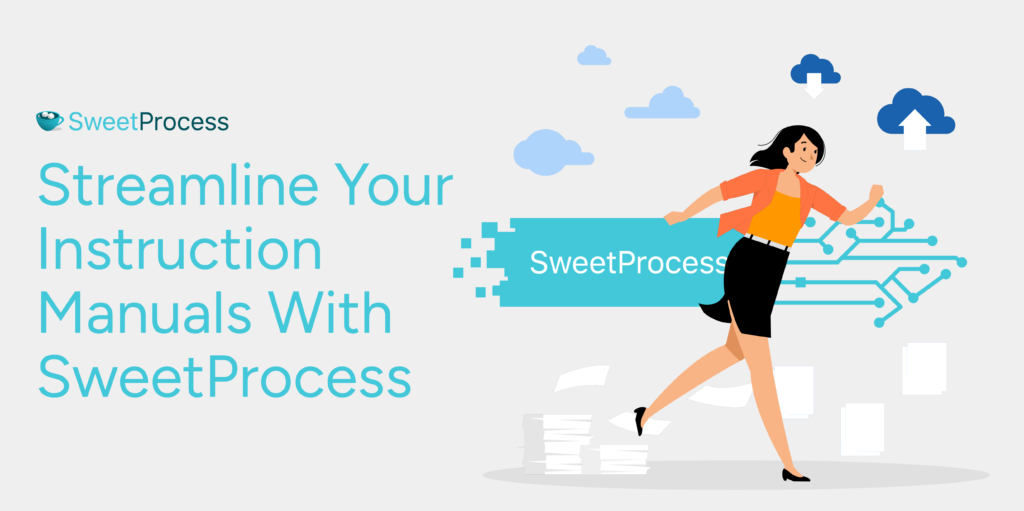
SweetProcess simplifies the entire process of creating, organizing, and maintaining a product instruction manual. With its intuitive, step-by-step format, built-in collaboration tools, and seamless updates, your business can ensure that every manual is clear, accessible, and always up to date. No more version confusion, no more missing steps, just streamlined, efficient documentation that works. Companies like Rise25, MonteVista Homes, and Spark Marketer have transformed their instruction manuals using SweetProcess. They’ve streamlined their operations, improved team productivity, and ensured that everyone has the right information when they need it.
Now, it’s your turn. Take the frustration out of creating instruction manuals. Start documenting your processes the smart way with SweetProcess today. Try SweetProcess for free and revolutionize your instruction manuals! Sign up for a free trial here, no credit card required.
